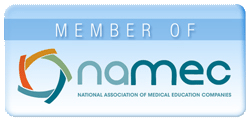Strategies for Success in Intrathecal Pain Management
Download Faculty Responses to Questions from the Live Symposium (PDF)
neuroscienceCME Webcast
Premiere Date: Wednesday, April 30, 2014This activity offers CE credit for:
- Physicians (CME)
- Nurses (CNE)
- Pharmacists (ACPE)
- Other
All other clinicians will receive a Certificate of Attendance stating this activity was certified for AMA PRA Category 1 Credit™
Credit Expiration Date:
Thursday, April 30, 2015
Note: Credit Is No Longer Available
 | David L. Caraway, MD, PhD Medical Director Center for Pain Relief Tri State, PLLC Huntington, WV |
 | Gladstone C. McDowell II, MD Medical Director Integrated Pain Solutions Columbus, OH |
Optimal pain management is a national healthcare priority and we have come a long way in improving the safe and effective use of opioid therapy for patients with both acute and chronic pain. However, for many patients with chronic pain that is severe and intractable, oral opioid therapy is not enough; other options are better suited to achieving pain control. One such option is intrathecal (IT) therapy, which is becoming an increasingly accepted strategy for using both opioid and non-opioid analgesics, and neuromodulators, for the management of intractable pain in appropriate patients. Applying evidence-based patient selection criteria is central to achieving success as are integrating trialing and individualizing the titration schedule for each patient. This replay of a symposium at at national pain meeting will provide the evidence and insight that are warranted to build and strengthen clinicians’ confidence and skill in the use of IT pain therapy.
This educational activity centers on the CMEO Make One Change Statement. This statement is crafted from pertinent quality measures or clinical guidelines as a performance challenge to all participants.
The Make One Change Statement for this activity is:
Identify patients who are candidates for intrathecal therapy (IT) pain management and devise and modify IT pain treatment plans to incorporate an algorithmic approach that balances efficacy and side effects, integrates an evidence-based titration strategy and addresses common barriers to care.
At the end of this CE activity, participants should be able to:
- Apply evidence-based, best practice criteria for appropriate patient selection for intrathecal pain management.
- Implement a slow dose-titration strategy for intrathecal pain management that maximizes efficacy while minimizing the potential for side effects.
- Integrate evidence-based trialing strategies into the decision-making process when developing an individualized treatment approach to pain management.
The following learning objectives pertain only to those requesting CNE or CPE credit:
- Review the evidence-based criteria for selecting patients for whom intrathecal pain therapy is appropriate.
- Analyze the strategies for a slow dose-titration for intrathecal pain management.
- Discuss with colleagues the development of an individualized treatment approach for intrathecal pain management.
Supported by an educational grant from Jazz Pharmaceuticals, Inc.
Pain specialists, physicians, physician assistants, nurse practitioners, nurses, pharmacists, and other health care providers with an interest in pain management.
CME Credit (Physicians):
CME Outfitters, LLC, is accredited by the Accreditation Council for Continuing Medical Education to provide continuing medical education for physicians.
CME Outfitters, LLC, designates this enduring material for a maximum of 1.0 AMA PRA Category 1 Credit™. Physicians should claim only the credit commensurate with the extent of their participation in the activity.
CNE Credit (Nurses):
Provider approved by the California Board of Registered Nursing, Provider Number CEP 15510, for 1.0 contact hours.
Note to Nurse Practitioners and Clinical Nurse Specialists: the content of this activity pertains to pharmacology. Earn up to 1 contact hour of pharmacotherapeutic contact hours.
CPE Credit (Pharmacists):
![]() CME Outfitters, LLC, is accredited by the Accreditation Council for Pharmacy Education as a provider of continuing pharmacy education. 1.0 contact hours (0.1 CEUs)
CME Outfitters, LLC, is accredited by the Accreditation Council for Pharmacy Education as a provider of continuing pharmacy education. 1.0 contact hours (0.1 CEUs)
Universal Activity Number:
0376-0000-14-001-H01-P (recorded programs)
Activity Type: knowledge-based
Post-tests, credit request forms, and activity evaluations must be completed online at www.cmeoutfitters.com/TST890 (requires free account activation), and participants can print their certificate or statement of credit immediately (80% pass rate required). This website supports all browsers except Internet Explorer for Mac. For complete technical requirements and privacy policy, visit www.neurosciencecme.com/technical.asp.
Disclosure Declaration
It is the policy of CME Outfitters, LLC, to ensure independence, balance, objectivity, and scientific rigor and integrity in all of their CME/CE activities. Faculty must disclose to the participants any relationships with commercial companies whose products or devices may be mentioned in faculty presentations, or with the commercial supporter of this CME/CE activity. CME Outfitters, LLC, has evaluated, identified, and attempted to resolve any potential conflicts of interest through a rigorous content validation procedure, use of evidence-based data/research, and a multidisciplinary peer review process. The following information is for participant information only. It is not assumed that these relationships will have a negative impact on the presentations.
Dr. Caraway has disclosed that he has received research and grant support from Jazz Pharmaceuticals, Inc. and Medtronic, Inc. He is on the speakers bureau of Jazz Pharmaceuticals, Inc. and Medtronic, Inc. He serves as a consultant for Jazz Pharmaceuticals, Inc. and Medtronic, Inc.
Dr. McDowell has disclosed that he has received research and grant support from Jazz Pharmaceuticals, Inc. and Medtronic, Inc. He is on the speakers bureau of Jazz Pharmaceuticals, Inc. and Medtronic, Inc. He serves as a consultant for Jazz Pharmaceuticals, Inc. and Medtronic, Inc.
Tony Graham, MD (peer reviewer) has nothing to disclose.
Ruth Cody, BSN, RN-BC (peer reviewer) has nothing to disclose.
Robert Kennedy (planning committee) has nothing to disclose.
Joy Bartnett Leffler, MLA, NASW, CSE (planning committee) has nothing to disclose.
Sandra Haas Binford, MAEd (planning committee) has nothing to disclose.
Sharon Tordoff, CCMEP (planning committee) has nothing to disclose.
Questions about this activity? Call us at 877.CME.PROS (877.263.7767).
MMV-052-043014-43



